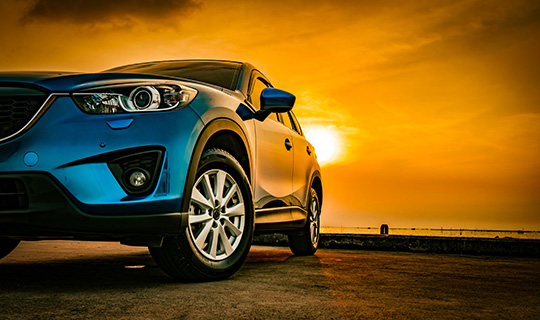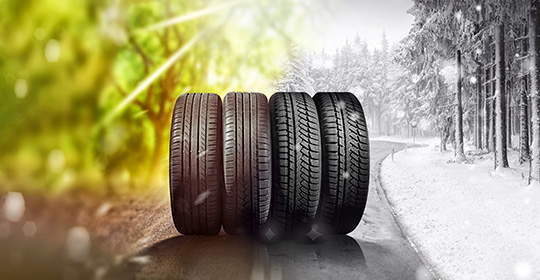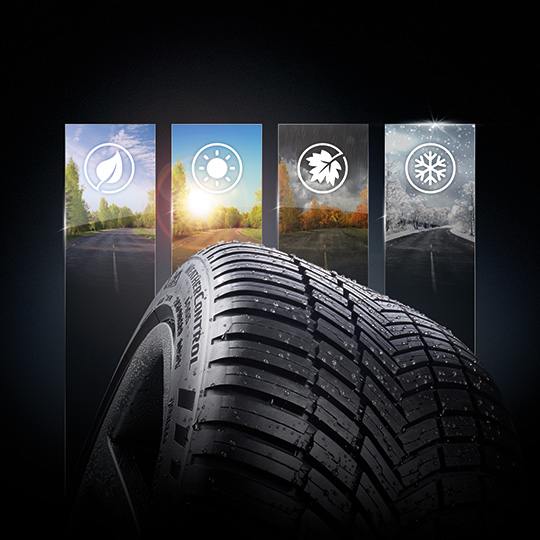What are summer tyres and why should you use them?
Summer tyres are manufactured for speed, control and longevity. They offer increased responsiveness, cornering, and braking capabilities, thanks to their tread patterns and rubber compounds that allow for improved precision on the road.
A summer tyre is the default option for most UK vehicles and is regarded as the standard tyre that you would fit your car, which would roll off the factory line with these tyres fitted for dry and wet surfaces when new.
The tread patterns of summer tyres have fewer grooves than winter and all-season tyres, with more rubber in contact with the road. They are designed to provide maximum road-holding grip and to remain more flexible, allowing for better traction and grip when temperatures are north of 7 degrees.
Summer tyres may have shallower tread depths that allow for more stability when pushed closer to their limits and they are generally more suitable and capable for increased performance in wet and dry conditions on high-performance, sports-oriented vehicles.
Summer tyres also provide better performance in wet weather, thanks to unique tread patterns that help evacuate water and resist aquaplaning.


Can you use winter tyres in summer?
With their special compounds and tread patterns, winter tyres are designed to stay soft and flexible in cold conditions, providing traction and grip in low temperatures on dry, wet and icy surfaces.
But as the temperature rises, winter tyres lose this advantage, grip declines and the tread starts to wear faster, so using winter tyres in summer is not advisable.
While winter tyres (snow tyres) are designed to provide friction between the snow-covered road surfaces and the tyre, this can impact fuel efficiency when there is no snow which, in the UK, is the vast majority of the time. Summer tyres are designed to cause less friction, so acceleration is faster and fuel economy is improved.
Summer tyres use a harder compound which does not become too soft and sticky on hot roads. In higher temperatures, summer tyres provide better all-around performance than winter tyres, particularly in braking and handling, wear resistance, rolling resistance and fuel economy.
Bridgestone tests show that the performance gap between summer and winter tyres in terms of braking and handling in hot weather can vary by between 30% and 8% respectively, depending on road conditions and temperature. In wet weather and an ambient temperature of about 30°C, a vehicle fitted with good quality summer tyres has a braking distance up to 30% shorter than a vehicle fitted with winter tyres. In certain conditions, this difference can even equal two times the length of the car!
Can you use summer tyres in winter?
It is not advisable when temperatures really begin to plummet. The rubber on summer tyres is designed for warm weather and when the mercury really begins to drop, the rubber gets stiff and the tyres lose traction, affecting handling and stopping distances as a result.
In winter weather, summer tyres have poor acceleration, with longer brake distances on ice or snow.
Winter tyres have been manufactured specifically for cold temperatures for a reason, and the technology behind winter tyres is really impressive.
For example, the Bridgestone Blizzak ICE delivers improved stopping distance on ice thanks to special Bridgestone Multicell technology, which is specially formulated with hydrophilic properties that attract water and draw it away from the surface of the ice to enhance grip.
The Blizzak ICE tyre achieves an 8% reduction in braking distance on ice[i] and has increased the tyre wear life by 25% compared to its predecessor[ii] This has been made possible by the new compound formula and the specially designed tread pattern.


Choosing a winter or summer tyre
Choosing the right tyre isn’t as simple as mounting a set and never looking back. When contemplating summer or winter tyres, consider your driving conditions, the climate you live in, and your performance needs. It is best that all tyres on your vehicle are the same type of tyre and your vehicle’s tyres should meet the manufacturer’s recommended size and speed rating.
What is the difference between summer tyres and all-season tyres?
An all-season tyre offers a balance of capabilities, providing acceptable performance in wet and dry conditions, as well as traction in snow. Built for the average driver, all-season tyres have moderate tread depths and rubber compounds that are engineered to provide longer tread life than summer tyres, which have shallower tread depths. Summer tyres, on the other hand, aren’t designed to perform exceptionally when temperatures drop significantly.
All-season tyres perform reasonably in warm weather, but they may offer less grip than summer tyres, sacrificing some steering, braking, and cornering capabilities. This trade-off is necessary for all-season tyres to be able to provide acceptable performance in light winter conditions and provide longer tread life. All-season tyres are capable of providing traction in winter but are not the best tyres to use in extreme winter driving conditions. Thankfully, we don’t tend to experience such conditions in the UK very often, thus making an all-season tyre a compelling choice. Drivers who encounter extreme winter weather may want to consider switching to snow tyres in the winter.
The beauty of an all-season tyre is that, unlike a winter tyre, it is designed to be kept on all year round and doesn’t need to be replaced for a summer tyre when springtime arrives. It is designed to be a versatile performer in all conditions.

Summer tyre care
Apart from changing to the appropriate seasonal tyres, it is also essential to take proper care of your summer tyres. For your driving safety, particularly handling and braking, the two most important steps are to regularly check your tyre inflation pressure, and tread depth.
First Stop recommends that you check your tyre inflation pressures fortnightly. If you’re not sure, you can find the car manufacturer’s recommended pressure levels in the car instruction manual, in the driver’s door frame, on the fuel cap lid, or on the glove box lid.
To measure your tread depth, place a 20p coin in a main groove; If you can see the outer rim of the coin, then the tyre is approaching the legal minimum tread depth and you should consider replacing it. Note that in mainland European countries the winter legal tread depth can be greater than 1.6mm (ref: Sweden: Winter thread depth: min. 3.0mm)
FAQ’s
For frequently asked questions about summer tyres and for more about the differences between summer, winter and all-season tyres, click here
Tyre advice page
At First Stop, our team of technical experts have created an online tyre advice hub with you in mind, from part-worn tyres to common tyre maintenance tips. For some simple, easy advice, visit here
We’re always on hand to provide expert tyre advice and our stores stock the most comprehensive summer tyres, all-season tyres, winter tyres, 4x4 tyres and run-flat tyres.